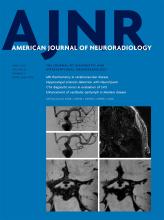Index by author
Nahmani, S.
- EDITOR'S CHOICEHead & NeckYou have accessComparison of Enhancement of the Vestibular Perilymph between Variable and Constant Flip Angle–Delayed 3D-FLAIR Sequences in Menière DiseaseS. Nahmani, A. Vaussy, C. Hautefort, J.-P. Guichard, A. Guillonet, E. Houdart, A. Attyé and M. EliezerAmerican Journal of Neuroradiology April 2020, 41 (4) 706-711; DOI: https://doi.org/10.3174/ajnr.A6483
The authors compared the degree of perilymphatic enhancement and the detection rate of endolymphatic hydrops using constant and variable flip angle sequences in 16 patients with 3T MR imaging. Both for symptomatic and asymptomatic ears, the median signal intensity ratio was significantly higher with the constant flip angle than with the heavily-T2 variable flip angle. Cochlear blood-labyrinth barrier impairment was observed in 4/18 symptomatic ears with the heavily-T2 variable flip angle versus 8/19 with constant flip angle sequences. They conclude that 3D-FLAIR constant flip angle sequences provide a higher signal intensity ratio and are superior to heavily-T2 variable flip angle sequences in reliably evaluating the cochlear blood-labyrinth barrier impairment.
Najim, N.
- PediatricsYou have accessThalamic Massa Intermedia in Children with and without Midline Brain MalformationsM.T. Whitehead and N. NajimAmerican Journal of Neuroradiology April 2020, 41 (4) 729-735; DOI: https://doi.org/10.3174/ajnr.A6446
Nickerson, J.P.
- Adult BrainYou have accessAnoxic Brain Injury Detection with the Normalized Diffusion to ASL Perfusion Ratio: Implications for Blood-Brain Barrier Injury and PermeabilityN. Li, M.A. Wingfield, J.P. Nickerson, D.R. Pettersson and J.M. PollockAmerican Journal of Neuroradiology April 2020, 41 (4) 598-606; DOI: https://doi.org/10.3174/ajnr.A6461
Nico, L.
- FELLOWS' JOURNAL CLUBAdult BrainYou have accessReliability of CT Angiography in Cerebral Vasospasm: A Systematic Review of the Literature and an Inter- and Intraobserver StudyL. Letourneau-Guillon, B. Farzin, T.E. Darsaut, M. Kotowski, F. Guilbert, M. Chagnon, A. Diouf, D. Roy, A. Weill, M. Lemus, C. Bard, M. Belair, D. Landry, L. Nico, A. Tellier, R. Jabre, C. Kauffmann and J. RaymondAmerican Journal of Neuroradiology April 2020, 41 (4) 612-618; DOI: https://doi.org/10.3174/ajnr.A6462
In Part I of this study, articles reporting the reliability of CTA up to May 2018 were systematically searched and evaluated. In Part II, 11 raters independently graded 17 arterial segments in each of 50 patients with SAH for the presence of vasospasm using a 4-category scale. Raters were additionally asked to judge the presence of any moderate/severe vasospasm and whether findings would justify augmentation of medical treatment or conventional angiography ± balloon angioplasty. The systematic review revealed few studies with heterogeneous vasospasm definitions. In Part II, the authors found interrater reliability to be moderate at best (ϰ > 0.6), even when results were stratified according to specialty and experience. They conclude that the diagnosis of vasospasm using CTA alone was not sufficiently repeatable among observers to support its general use to guide decisions in the clinical management of patients with SAH.








